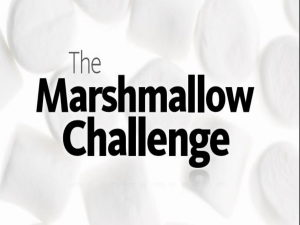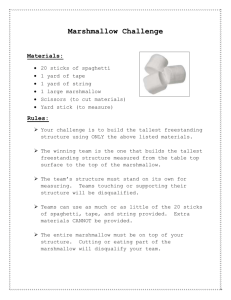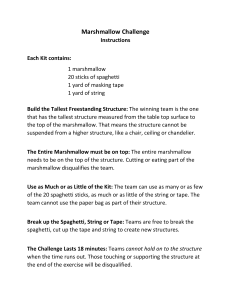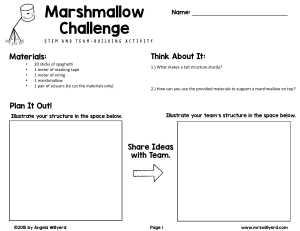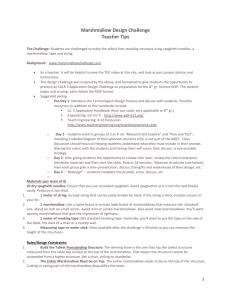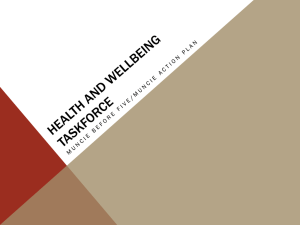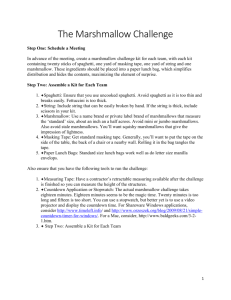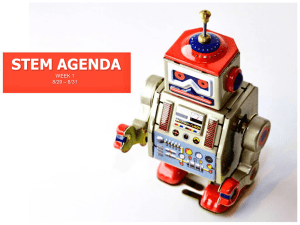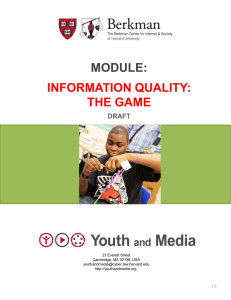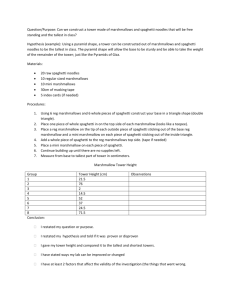Engineering Design Challenge PP
advertisement
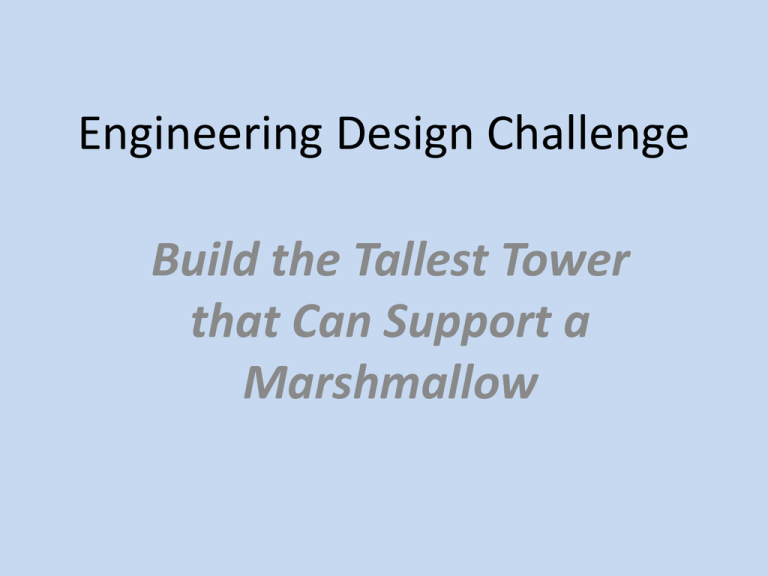
Engineering Design Challenge Build the Tallest Tower that Can Support a Marshmallow Set-up • Get in groups of 3-4 people • 20 sticks of spaghetti, 1 marshmallow • 1 yard of masking tape • 1 yard of string RULES Build the Tallest Freestanding Structure: The winning team is the one that has the tallest structure measured from the tabletop surface to the top of the marshmallow. That means the structure cannot be suspended from a higher structure, like a chair, ceiling, or chandelier. The Entire Marshmallow Must Be On Top: The entire marshmallow needs to be on the top of the structure. Cutting or eating part of the marshmallow disqualifies the team. Use as Much or as Little of the Kit: Team can use as many or as few of the 20 spaghetti sticks, as much or as little of the string or tape. Break up the Spaghetti, String or Tape: Teams are free to break the spaghetti and to cut up the tape and string to create new structures. The Challenge Lasts 15 minutes: Teams cannot hold on to the structure when the time runs out. Those touching or supporting the structure at the end of the exercise will be disqualified. What did you learn? • Discuss with your group and be ready to share what you learned from this activity. ENGINEERING DESIGN Performance Expectations K-2-ETS1-1. Ask questions, make observations, and gather information about a situation people want to change to define a simple problem that can be solved through the development of a new or improved object or tool. K-2-ETS1-2. Develop a simple sketch, drawing, or physical model to illustrate how the shape of an object helps it function as needed to solve a given problem. K-2-ETS1-3. Analyze data from tests of two objects designed to solve the same problem to compare the strengths and weaknesses of how each performs. 3-5-ETS1-1. Define a simple design problem reflecting a need or a want that includes specified criteria for success and constraints on materials, time, or cost. 3-5-ETS1-2. Generate and compare multiple possible solutions to a problem based on how well each is likely to meet the criteria and constraints of the problem. 3-5-ETS1-3. Plan and carry out fair tests in which variables are controlled and failure points are considered to identify aspects of a model or prototype that can be improved. ENGINEERING DESIGN Performance Expectations MS-ETS1-1. Define the criteria and constraints of a design problem with sufficient precision to ensure a successful solution, taking into account relevant scientific principles and potential impacts on people and the natural environment that may limit possible solutions. MS-ETS1-2. Evaluate competing design solutions using a systematic process to determine how well they meet the criteria and constraints of the problem. MS-ETS1-3. Analyze data from tests to determine similarities and differences among several design solutions to identify the best characteristics of each that can be combined into a new solution to better meet the criteria for success. MS-ETS1-4. Develop a model to generate data for iterative testing and modification of a proposed object, tool, or process such that an optimal design can be achieved. HS-ETS1-1. Analyze a major global challenge to specify qualitative and quantitative criteria and constraints for solutions that account for societal needs and wants. HS-ETS1-2. Design a solution to a complex real-world problem by breaking it down into smaller, more manageable problems that can be solved through engineering. HS-ETS1-3. Evaluate a solution to a complex real-world problem based on prioritized criteria and tradeoffs that account for a range of constraints, including cost, safety, reliability, and aesthetics, as well as possible social, cultural, and environmental impacts. HS-ETS1-4. Use a computer simulation to model the impact of proposed solutions to a complex real-world problem with numerous criteria and constraints on interactions within and between systems relevant to the problem. Does this activity meet the intent of Engineering Design in NGSS? Synthesized Appendix I – Engineering Design in NGSS K-2 DEFINE & DELIMIT Identify situations that people want to change as problems that can be solved through engineering Convey possible DEVELOP solutions through SOLUTIONS visual or physical representations OPTIMIZE Compare solutions, test them, and evaluate each 3-5 6-8 9-12 Specify criteria and constraints that a possible solution to a simple problem must meet Attend to precision of criteria and constraints and considerations likely to limit possible solutions Attend to a broad range of considerations in criteria and constraints for problems of social and global significance Research and explore multiple possible solutions Combine parts of different solutions to create new solutions Break a major problem into smaller problems that can be solved separately Improve a solution based on results of simple tests, including failure points Use systematic processes to iteratively test and refine a solution Prioritize criteria, consider tradeoffs, and assess social and environmental impacts as a complex solution is tested and refined
